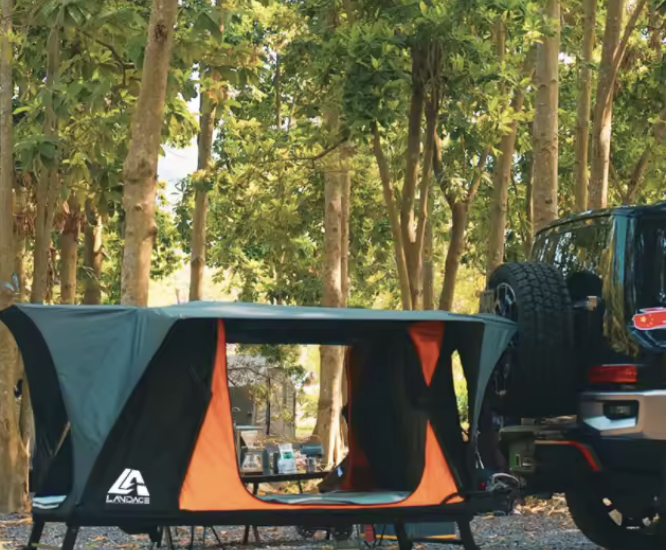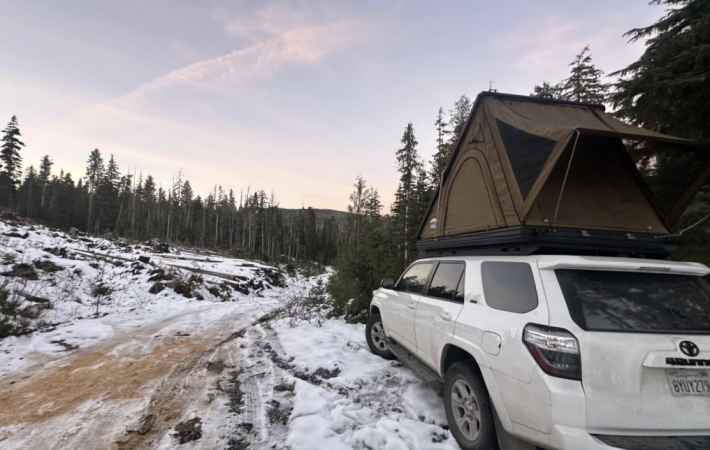Rooftop, hitch-mounted, and ground tents, what actually matters this year
Choosing a tent in 2025 is less about brand names and more about the few design choices that determine whether you sleep well and tear down fast. Below is a practical guide to the features that keep showing up across the best rooftop tents (RTTs), the new wave of hitch-mounted systems, and modern ground tents. Use this as a lens to evaluate any model you’re considering.
Fast, repeatable setup
Speed is safety and comfort. The best RTTs now deploy in one motion and lock into place without wrestling fabric or extra poles. Wedge and clamshell designs are the standouts because the hinge provides structure immediately; you release two latches, push, and the gas struts do the rest. Fold-out “hybrid” RTTs remain a strong option when you need more floor space, but they take a little longer and require a soft cover. Ground tents have also evolved: hub/instant frames allow a single person to pitch a stable shelter in about a minute, ideal when wind or rain is building.
Real weather performance, not just marketing
Four-season capability comes from a few simple ingredients: a rigid shell or strong pole architecture, quality ripstop fabric, and tight control of seams and openings. Aluminum-shell RTTs paired with poly-cotton walls handle wind and shed rain well, while premium ground tents use robust poles and guy-out geometry that keeps the canopy taut. If you travel in coastal or high-wind regions, prioritize structure first; fabric quality matters, but structure keeps the shape that lets fabric do its job.
Condensation management, you can feel
Moisture is the silent trip killer. Look for tents with always-open roof vents that sit under protective cowls, so they breathe even in sideways rain. Blackout liners are popular for sleeping past sunrise; the good ones include hidden vent pathways so you don’t trap damp air. Inside RTTs, an anti-condensation mat under the mattress is a small investment that keeps the base dry and the bed warmer. Some premium models now add quiet, low-draw fans to move air on still, wet nights, handy on the coast and in shoulder seasons.
Sleep quality beyond the logo
Mattress density and support matter more than almost anything else. A thicker, high-density foam pad (or an upgrade to memory foam) turns a long trip from “tolerable” to “restorative.” Blackout interiors reduce early light and help with cooler temperatures at dawn. Well-placed pockets, boot bags at the ladder, and a clean interior lighting strip are small details that keep the sleeping area organized and calm.
Weight, profile, and vehicle limits
Every vehicle has roof load ratings, dynamic while driving and static when parked. Newer RTTs aim to stay slim and hover in the ~110–140 lb range, which helps handling and fuel economy while giving you headroom for crossbars or solar on top of the shell. If your roof is already busy with kayaks or cargo, consider a hitch-mounted tent or a ground tent to keep weight off the roof entirely.
Mounting systems and ecosystems
The best tents behave like mini basecamps. Perimeter tracks, crossbar options, and Molle panels let you add awnings, annex rooms, privacy showers, or storage without improvised brackets. Thoughtful cable pass-throughs and interior wire channels avoid the “string lights and tape” look. Over time, an ecosystem saves money because you can reconfigure the same tent for solo missions, family trips, or winter setups.
RTT shapes, how to choose
Wedge RTTs open the quickest and offer generous headroom toward the hinge side, making them excellent for fast moves and foul weather. Clamshell RTTs trade a small amount of speed for broader interior space and panoramic windows. Fold-out hybrids pack shorter on the roof yet open to a large sleeping platform; they’re ideal when you want maximum floor area and don’t mind a couple of extra steps.
Hitch-mounted tents, detachable basecamps
Hitch tents mount to a 2″ receiver, ride vertically while driving, and stand on adjustable legs at camp. The benefit is flexibility: you set up, leave the tent in place, and take the vehicle exploring or into town without a full teardown. You also avoid a heavy box on the roof, which can improve fuel economy and reduce wind noise. Before choosing this route, check your vehicle’s tongue-weight rating, the system’s deployed load rating, and any clearance issues with swing-outs or tailgates. For many travellers, a hitch system delivers RTT-style comfort with fewer compromises to everyday driving.
Ground tents still earn their place
Modern ground tents are not the floppy, slow setups you remember. Instant frames create a freestanding shelter in seconds, tall interiors make changing easy, and newer designs integrate heater ports and closable high vents for safe use with portable heaters in cold conditions. If your rig’s roof is reserved for bikes, boards, or solar, a high-quality ground tent is the most flexible option.
How to decide: a practical checklist
Start with your travel rhythm. If you move camp nightly or chase weather windows, choose a fast-deploy RTT, wedge first, clamshell second. If you need abundant floor space for kids or pets, a fold-out hybrid works well, provided you’re comfortable with a soft cover and a few extra steps. If you want detachable convenience, better mileage, and a quiet ride, a hitch-mounted system is compelling. For maximum versatility at the lowest cost, and if roof space is precious, a modern hub-style ground tent is still an excellent choice. Across all types, insist on effective venting, a quality mattress, tidy interior lighting, and a mounting ecosystem that can grow with you.
The “best” overlanding tent in 2025 is the one that sets up quickly, stays dry, manages condensation, lets you sleep well, and fits your vehicle and travel style, roof, hitch, or ground. If you want help matching your rig, climate, and budget to the right direction, reach out; we’re happy to give you a straight, no-nonsense recommendation.







Leave a comment
Your email address will not be published. Required fields are marked *